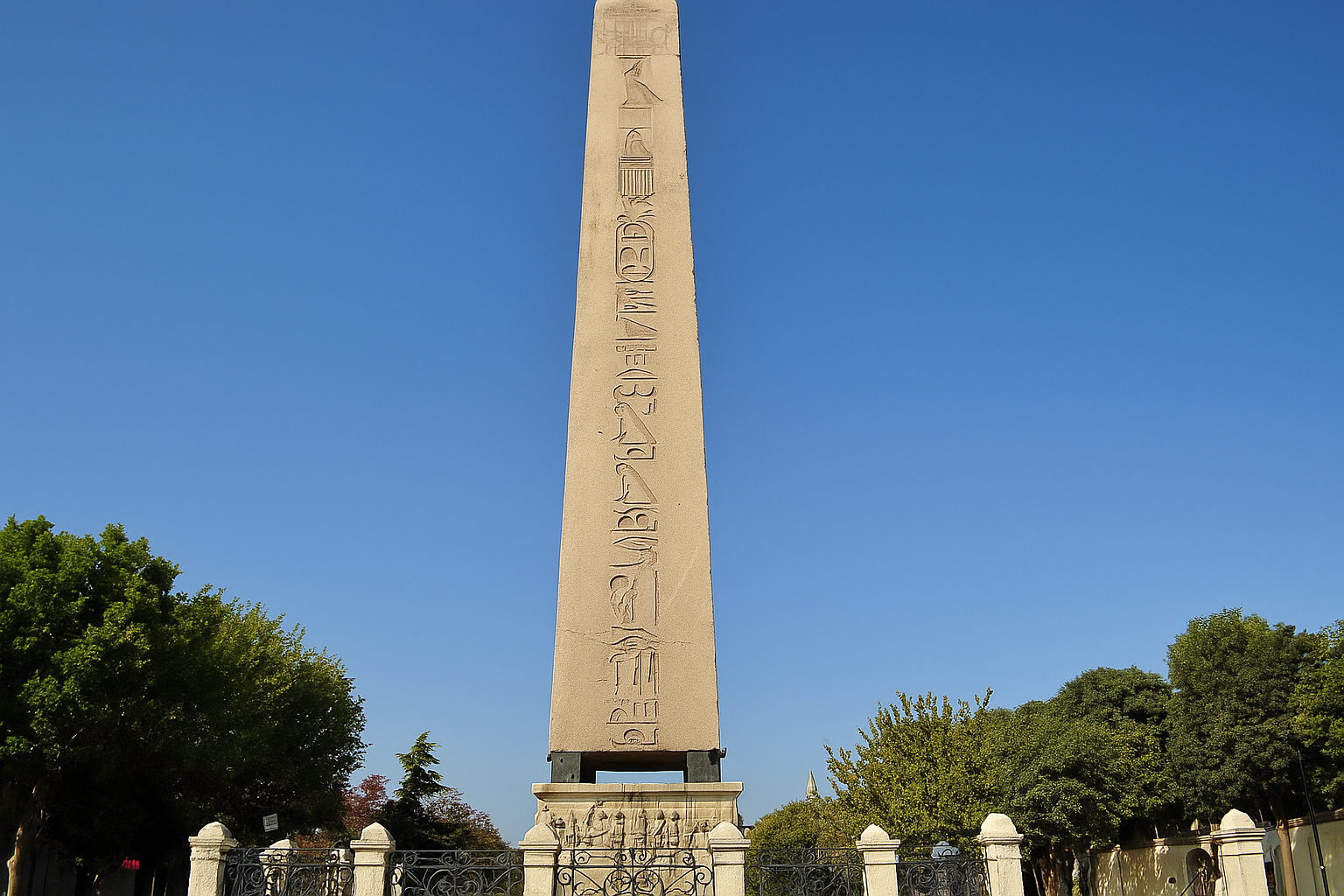
Dikilitaş (Obelisk of Theodosius)
HISTORICAL BACKGROUND AND SIGNIFICANCE
The Dikilitaş, or the Obelisk of Theodosius, stands proudly in the Hippodrome of Constantinople, now known as Sultanahmet Square in modern-day Istanbul. This ancient monument dates back to 1,500 BC and was originally erected in Heliopolis, Egypt, during the reign of Pharaoh Thutmose III. The obelisk was brought to Constantinople by Emperor Theodosius I in 390 AD as a symbol of the Roman Empire's power and its connection to the ancient civilizations of Egypt. The relocation of the obelisk was part of Theodosius's efforts to consolidate his rule and to celebrate the triumphs of the Roman Empire, showcasing the continuity of imperial authority from the ancient world to his time.
ARCHITECTURAL FEATURES AND DESIGN ELEMENTS
The Obelisk of Theodosius is made of red granite and stands approximately 20 meters tall, with a total height of around 32 meters when including its base. The obelisk is adorned with intricate hieroglyphics that depict the achievements of Pharaoh Thutmose III, including scenes of battle and offerings to the gods. The base of the obelisk, which was added during its installation in Constantinople, features reliefs that celebrate Theodosius's own victories in the chariot races held at the Hippodrome. The obelisk's tapering form and the hieroglyphs reflect the architectural style of ancient Egyptian obelisks, while the addition of the base signifies the Roman adaptation of this ancient art form.
CULTURAL AND RELIGIOUS IMPORTANCE
The Obelisk of Theodosius is not only a remarkable piece of ancient architecture but also a significant cultural artifact that represents the blend of Egyptian and Roman influences in the Byzantine Empire. It serves as a reminder of the power dynamics of the ancient world and the way in which rulers utilized monumental architecture to convey their authority. The obelisk also holds religious significance, as it was originally erected in a temple dedicated to the sun god Ra in Heliopolis. In its new context, it became part of the Christian narrative of the Byzantine Empire, symbolizing the triumph of Christianity over paganism and the continuity of divine favor through the ages.
VISITOR EXPERIENCE AND WHAT TO EXPECT
When visiting the Dikilitaş, visitors can expect to be immersed in the rich history of Istanbul. The obelisk is located in the heart of Sultanahmet Square, surrounded by other historical landmarks such as the Hagia Sophia and the Blue Mosque. The area is bustling with tourists, street vendors, and local residents, creating a vibrant atmosphere. Visitors can walk around the obelisk, taking in its grandeur and the detailed carvings that tell stories of ancient battles and victories. There are benches nearby where one can sit and reflect on the history that surrounds them, making it a perfect spot for photography and relaxation.
INTERESTING FACTS AND ANECDOTES
1. The Obelisk of Theodosius is one of the few remaining monuments from the ancient Hippodrome, which was once the center of public life in Constantinople, hosting chariot races and public gatherings. 2. The obelisk has survived numerous earthquakes and the ravages of time, making it a testament to the engineering prowess of ancient civilizations. 3. In the 19th century, the obelisk was the subject of a famous painting by the artist Jean-Leon Gerome, which captured its majestic presence in the bustling city. 4. The obelisk is often overlooked by visitors who are more drawn to the nearby Hagia Sophia and the Blue Mosque, making it a hidden gem for those who take the time to explore the square.
PRACTICAL VISITING INFORMATION
- **Hours**: The Dikilitaş is located in Sultanahmet Square and is accessible at all hours. There are no entry fees, making it a convenient stop for visitors. - **Best Times to Visit**: Early morning or late afternoon are ideal times to visit to avoid the midday heat and crowds. The soft light during these times also enhances the beauty of the obelisk for photography. - **Tips**: 1. Take a guided tour to gain deeper insights into the history and significance of the obelisk and the surrounding area. 2. Bring water and wear comfortable shoes, as you may want to explore the entire Sultanahmet area, which is rich in history. 3. Visit nearby attractions such as the Hagia Sophia and the Blue Mosque to make the most of your time in this historic district. 4. Don’t forget to check out the nearby cafes and shops for a taste of local cuisine and souvenirs.
In conclusion, the Dikilitaş (Obelisk of Theodosius) is a remarkable historical monument that encapsulates the grandeur of ancient civilizations and their enduring legacies. A visit to this iconic structure not only enriches your understanding of Istanbul's rich history but also allows you to appreciate the cultural tapestry that defines this vibrant city.